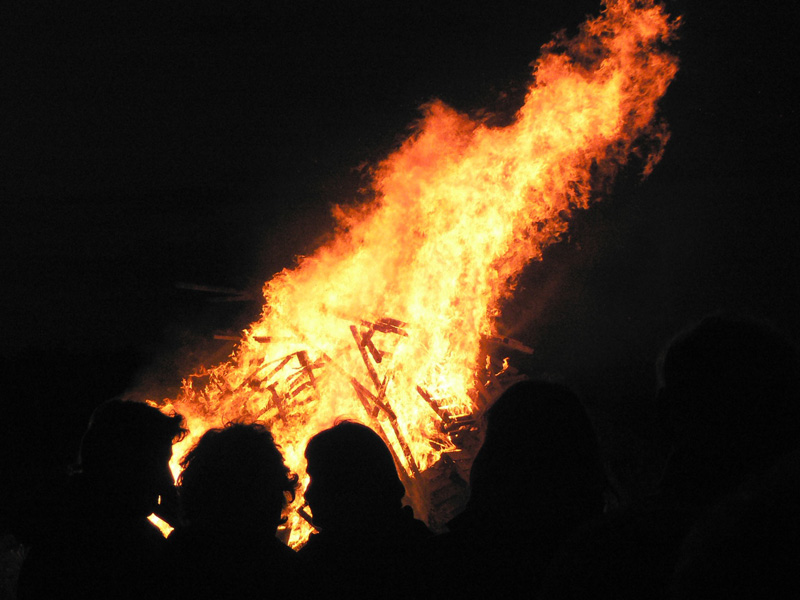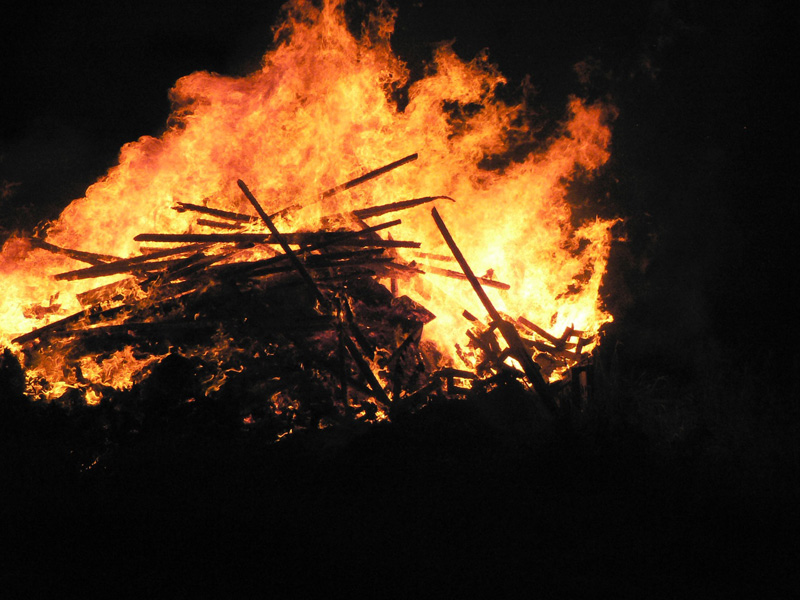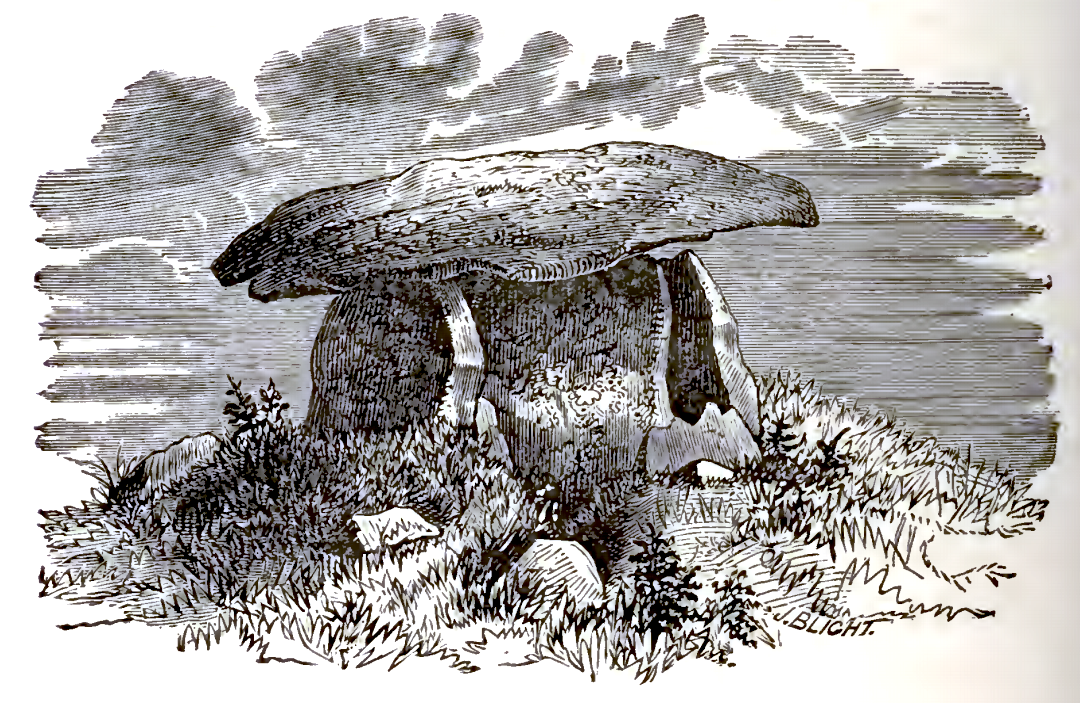Cornwall
Bonfire of the Baptist
Wednesday, 17 September, 2014.

At the end of a long journey into Cornwall, crumpled into a corner of a train, I was longing to get out on the open moor. Aside from the cattle truck stylings of British rail travel, the journey only reinforces the impression that Cornwall is a very long way from anywhere. And, along with the promise of witnessing an event that, though once widespread, only occurs now in Cornwall, it is this remoteness that brings me here.
“Here” turns out to be somewhere between Penzance and Zennor in a field near the hamlet of Boswarthen which is, itself, to be found just off an isolated road north of Madron. Despite the abundance of placenames, each of which sounds like the grave syllables of a mumbled prayer, I am effectively bang-slap in the middle of nowhere.
I’m here for a bonfire, specifically a midsummer’s eve bonfire on top of a hill overlooking Mounts Bay – one of at least half a dozen such events arranged by local Old Cornwall Societies up and down the county. The guiding principle of these societies is to hold on to the old customs and keep them alive for the next generation – a process of ‘gathering the fragments’ of Cornish culture, language and traditions which has steadily grown in popularity over the years. Sure enough, the secluded lane quickly fills with parked cars as organisers and spectators turn up, almost all at once. People of all ages are here, from the local Young Farmers who are having a barbecue in the back of a horse box, to a strong contingent of senior villagers.
“Health and safety would probably want us to put up a barrier around that”, says Roy Matthews, Honorary Chairman of the Madron Old Cornwall Society, waving in the general direction of a 12 foot high pyramid of old pallets and fertiliser bags. “But the thing with a fire is that it’s hot, you see. Nobody’s going to be able to get anywhere near it once it’s lit.”
He goes on to explain some of the history of the bonfires. Thousands of years ago, animal sacrifices would be made on them. “Sometimes, they’d throw the odd criminal on”, says Matthews, with a playful gleam in his eye, “but now we throw a wreath on instead.”

By about 9 pm, around seventy people have crowded into the small field. The air is thick with the smell of the horse box burgers, dozens of conversations have coalesced into a soft murmur, at which point we are handed our photocopied song sheets – along with a steely warning to return them later. We are to be accompanied by the parish priest, the Rev. Tim Hawkins who, rather than appear here in an official capacity, has brought his viola along instead.
At first I mouth the words, like a self-conscious schoolboy in morning assembly, as I don’t wish to appear impolite, but I am eventually swept up in it all - the beautiful location, the camaraderie and the life-affirming spirit of a sing-along at 700 feet. Undaunted by my lack of vocal talent, I join in with Hail to the Homeland and Going Up Camborne Hill, Coming Down and my mind is elevated from its usual default settings. I have become one of them.
As night draws in, and with the final chorus of Trelawney still ringing in my ears, the ceremony begins in earnest with the reading of the prayer – first in Cornish, then English. When the ancient Celts were converted to Christianity, the fires were transformed, with the early Church’s usual resourcefulness, into celebrations of the Feast of St John the Baptist. As a result, every bonfire now has a benediction which includes a couple of priceless puns about “being lighted by Thy grace and fired with Thy love”.
After a brief explanation of the symbolism of the bouquet of herbs that are to be thrown in to the fire – in place of a local ne'er-do-well – and some words from the Master of Ceremonies, a man appears with a bottle of white spirit to set things off in style. It’s only moments before the pyre is blazing furiously away, its wild flames clawing at the inky blue-black sky. For all the layers of ceremony, etiquette, poetry and faith superimposed over the night, the fire itself is the focus and this is as it would have been for our ancestors, a celebration of summer through the building of a simulacrum of the sun itself.
Clinging onto those thoughts, I wind down the narrow lane home. A Cornwall Fire Brigade engine with sirens screaming and blue lights blazing appears from nowhere, heading in the direction of the flames I have left behind. For all the efforts of the organisers, it seems that the wild old and the ordered new Cornwall are yet to be reconciled.
Comments
A Sense of Place
Friday, 20 September, 2013.

We tramped in total darkness across the Penwith moor in search of Chûn Quoit, the ancient remains of a round barrow – the final resting place of some long-forgotten tribal chieftain. To anyone who hasn’t seen one, a quoit – the Cornish name for a cromlech – is a structure that calls to mind the offspring of a colossal stone mushroom and a 12 foot milking stool. Four granite ‘legs’, each a slab of 20 tons, support a substantial capstone, all of which would once been hidden under a mound of earth. With its bare bones revealed there is an elemental quality about the structure – even on a bright day it has an austere menace that would put the willies up Boris Karloff, but picked out in torchlight against the midnight sky it was quite terrifying. The terror was all the more real because the night before, in a well-lit, warm and comfortable house, I had volunteered to sleep in it in the name of cognitive archaeology.
The idea was to record my dreams and to analyse them to see if they contained any interesting symbolism – symbolism which would hint at some hidden aspect of the place. My guide, companion and the man who would note down my nocturnal ravings was Paul Devereux, author of a slew of books on earth mysteries that treat the fluffy air-head dogmas of new age thinking with the skepticism they deserve in favour of original research into the unanswered questions raised at the fringes of science, culture and anthropology.
Paul happened to be a neighbour of mine and we shared a common interest, though my investigations of the fortean world were shambling and shallow in comparison. Only a couple of nights before he had handed me a sachet of what looked like sweepings from the barn floor to make up into a cold tea. The sawdust and twig infusion claimed that it would open up the third eye and help me to dream of interesting things but it tasted as bad as it looked and my third eye remained firmly shut, possibly in disgust.
We picked our way over the rocky terrain that lay between our car and the quoit, determined to keep to the well worn path. This part of Cornwall was mined for tin ore until the nineteenth century and some of the miners moonlighted on their own undocumented tunnels to make ends meet. As a consequence, Penwith has more holes in it than cartoon cheese – a fact that is underlined periodically when a cow goes hurtling down a mine shaft or somebody’s driveway unexpectedly disappears into the abyss.
After a quarter of an hour we arrived at Chûn and I crawled through the narrow opening.
To say the chamber was dank and claustrophobic doesn’t do it justice. Imagine a very small tent made out of five slabs of rock leaning on one another in a house of cards configuration, except that the cards weigh as much as 20 tons each. Rounded fragments of granite, rooted in the floor of the chamber, found hitherto undiscovered vertebrae which ever way I shifted myself to get comfortable, but it was the gnawing sense of ill-ease that was the real enemy of rest. Outside the chamber, the sky was as black as a bin liner, but inside, my mood had darkened to match.
Paul explained what the plan for the evening was. I was to doze off and be rudely awoken once I had begun to dream, at which point I would be expected to babble it all out before it had a chance to scuttle away into the night or my conscious mind made too much sense of it.
“But how will you know when I’m dreaming?”
“You’ll go into REM sleep – and I’ll be able to pick up your rapid eye movements with this”, said Paul, as he dug into his knapsack.
I half expected him to present me with a little scientific gizmo of some kind – maybe an electrode for my temple, a sensor on the end of a colour-coded wire or a coiled cable that led to an adapted moped helmet. So I was quite disappointed when he pulled out a bicycle lamp – a rear lamp which, he informed me, would enable him to catch my eye movements without disturbing me unduly.
It took another hour for my mood to melt from its agitated state. I was just drifting off peacefully, snatching the first images of the night, feeling the hypnogogic whirl into the vortex of dreams when I was pulled back from the brink of the plughole by the glow of a bicycle lamp in my eyes. After gabbling out some inconsequential mutterings, it was clear that we were all a little disappointed. We went home, exhausted, with no concrete dreams and only the memory of dark menace to console us.
From
Naenia Cornubia
A descriptive essay illustrative of the sepulchres and funereal customs of the early inhabitants of the County of Cornwall.William Copeland Borlase, BA, FSA
CHYWOONE CROMLECH
The most perfect and compact Cromlech in Cornwall is now to be described. It is situated on the high ground that extends in a northerly and westerly direction from the remarkable megalithic fortification of Chywoone or Chuun, in the parish of Morvah.The " Quoit" itself, which, seen from a distance, looks much like a mushroom, is distant just 260 paces from the gateway of the castle; and about the same distance on the other side of it, in the tenement of Keigwin, is a barrow containing a deep oblong Kist-Vaen, long since rifled, and now buried in furze.
Thinking this monument the most worthy of a careful investigation of all the Cromlechs in the neighbourhood, the author proceeded to explore it in the summer of 1871, with a view to determine, if possible, the method and means of erection in the case of such structures in general.
